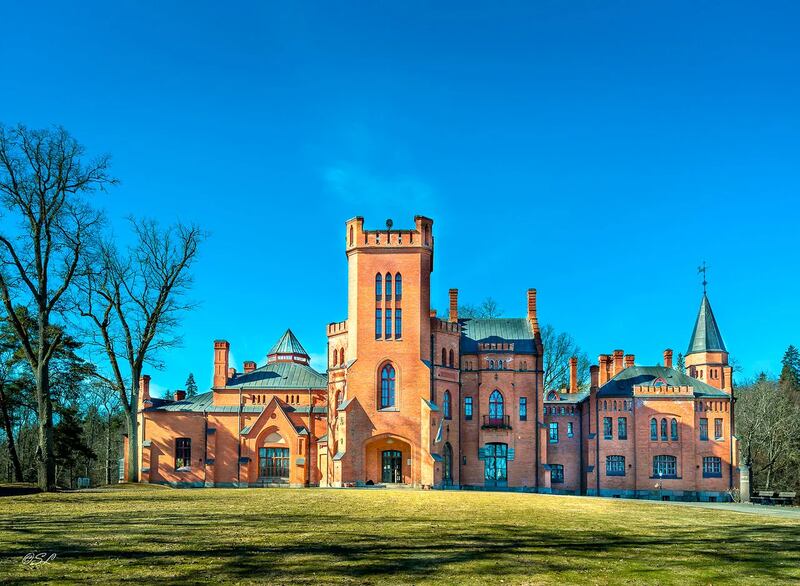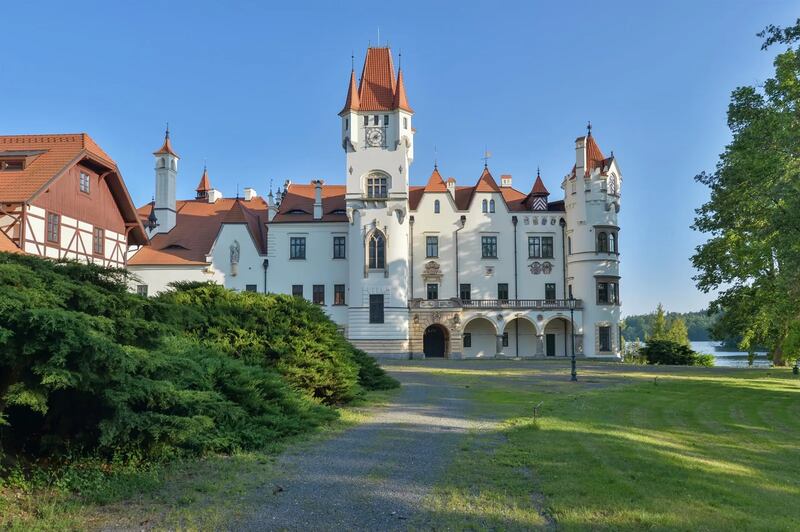
In Georgian England, it was customary for members of the peerage to establish a country seat. Thus it was that Horace Walpole, 4th Earl of Orford, the English writer, man of letters, antiquarian, and Whig politician, established a taste for Gothic castles in the countryside. He purchased “Chopp’d Straw Hall,” a villa on the Thames in Twickenham, West London, and called it Strawberry Hill House.
From 1747 to 1797, Walpole transformed the villa into Britain’s greatest example of Gothic Revival architecture. There, in the summer of 1764, after waking from a dream in the “gloomth” of his “little Gothic castle,” Walpole began his seminal work, The Castle of Otranto, the first Gothic novel.
Herewith, Luxury Defined presents a collection of country seats, great and grand, in the Gothic tradition. Consider the Castle of Vincigliata, an 11th-century fortress in the hills above Florence; a 19th-century neo-Gothic manor in Southern Estonia, fashioned after England’s Windsor Castle; a beautifully restored 15th-century castle in Brittany, France; or Château Žinkovy, the largest privately owned castle in the Czech Republic. Step across the drawbridge beneath the crenellated walls into the magical medieval mysteries of the Gothic—Walpole’s world.
1. The Castle of Vincigliata in Fiesole, Tuscany, Italy
A historic landmark in the hills above Florence, the Castle of Vincigliata was built as a fortress in the mid-11th century.
Its ruins were purchased in 1855 by John Temple-Leader, an enigmatic English politician, connoisseur, and author who was, as British writer Harold Acton wrote, “one of those unmistakable representatives of Albion, who took root amongst the vineyards and became part of the landscape.” Lord John hired architect Giuseppe Fancelli and the finest Florentine artisans to rebuild the castle in high Neo-Gothic style.
Today, a monument to the Romantic temperament, it finds glorious use as a wedding venue. The castle, its ancillary structures, and grounds extend to 34.6 acres of formal Italian gardens, parkland, woodland, meadows, Sangiovese vineyards, and olive groves.
How lovely is this property? When Queen Victoria visited in 1893, she was moved to paint a watercolor of the scene.
2. Sangaste Castle in Otepaa, Estonia
 Opens in new window
Opens in new windowA historic 37-acre estate dating from the 13th century, Sangaste Castle in South Estonia is an exemplar of Gothic Revival architecture with Tudor influences.
The castle was built circa-1881 for the nobleman Friedrich Georg Magnus von Berg, the “Rye Count” who developed a hardy strain of winter rye that is still cultivated worldwide today. The count had visited and admired England’s royal Windsor and Balmoral castles.
The castle’s stark Gothic central tower (with its grand, arched doorway and columned entrance hall), arched window and vaulted interiors are relieved by Tudor graces: imposing asymmetrical wings, tall chimneys, towers, balconies, covered walkways, and hardwood parquet floors.
There is an elegant courtyard, a chapel, watchtower, and glass-enclosed conservatory. Auxiliary buildings include stables, a dairy, barn, and water tower. The lovely parklike grounds are composed of an arboretum, forests, and ponds.
Related: Discover Luxury Homes with Libraries
3. Château in Brittany, France
The magnificent castle sits on nearly 100 acres of wooded parkland along the River Aven in southern Brittany.
Built and developed from the 15th to the 18th centuries, the limestone structure fell into disrepair until extensive restoration and renovation over the last 20 years brought it into the 21st century.
The restoration took roughly seven years to dismantle the structure stone by stone, with a crew of seven stonemasons permanently on-site. They created a granite quarry on the property to acquire new stone. The artisans’ contemporary touches nevertheless respect the structure’s antiquity.
Within the ancient walls are innovatively updated interiors extending to nearly 25,000 square feet. Among the medieval features are the original solid-stone spiral staircase and a great room with a monumental limestone fireplace and beamed ceiling.
There are several original buildings, including the chapel, monk’s tower, honey shed, and flax drying shed. The property also includes a boathouse on the river, a workshop, garage, caretaker’s house, staff lodge, and detached guest house. A natural granite swimming pool and several themed gardens seamlessly blend into the medieval environs.
4. Château Žinkovy in Plzen mesto, Czech Republic
 Opens in new window
Opens in new windowChâteau Žinkovy is the largest privately owned castle in the Czech Republic. This magnificent estate encompasses 47 acres of formal gardens, parkland, and farmland surrounded by an idyllic landscape of lakes and ancient forests in the Pilsen region of West Bohemia.
The centerpiece is the fairy-tale castle, built as a fortress in the 12th-century. Ownership went eventually to the knights of Wesselý, who commissioned Viennese theatrical architects Fellner and Helmer to build the striking neo-Renaissance façade. The Škoda car-manufacturing family owned the property until the end of WWII when it was taken over by the government.
The château is defined by its towers, balconies, covered walkways, and statuary. The complex extends to 123,709 square feet and includes offices, a restaurant, conference rooms, four apartments, and extensive parking (ideal for weddings and corporate retreats).
A mill, granary, outbuildings, a partially renovated farm with 12 bungalows (six of which are refurbished), a well with a spring, and a water treatment plant complete the amenities.
Enter the world of legend and lore here.


